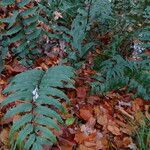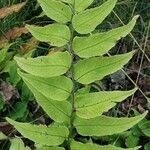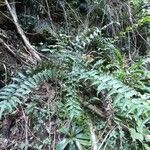Plants 25-50 cm tall. Rhizome erect, densely covered with brown scales. Stipe stramineous, 12-26 cm, 2-3 mm in diam. at base, lower portion densely scaly; scales brown, sometimes with a dark brown central stripe, ovate or lanceolate, dentate. Lamina oblong-lanceolate, 20-42 × 8-14 cm, base not contracted or slightly contracted, 1-imparipinnate, apex obtuse; rachis with sparse lanceolate or linear brown scales. Lateral pinnae 7-16(-29) pairs, alternate, nearly spreading, shortly stalked, lanceolate, ± falcate; middle pinnae 5-8 × 1.2-2 cm, base oblique, acroscopic margins subtruncate and sometimes with weak, blunt auricles, basiscopic margins cuneate, margins entire or sometimes serrulate, apex acuminate or rarely caudate; terminal pinna ovate-lanceolate, sometimes lower portion with 1 or 2 lobes, 3-6 × 1.5-3 cm; papery, glabrous on both surfaces; venation pinnate, slightly raised abaxially, indistinct adaxially, veinlets anastomosing to form 4 or 5 rows of areoles on each side of midrib, each areole with 1 or 2 included free veinlets. Sori throughout abaxial surface of pinnae; indusia grayish, margins entire.
More
A tufted fern. It grows 25-50 cm tall. It loses its leaves in colder climates. The fronds are oblong and 20-42 cm long by 8-14 cm wide. It has leaflets along the stalk. These are sickle shaped and dull green.
Varieties 3 (1 in the flora): North America, Asia.



